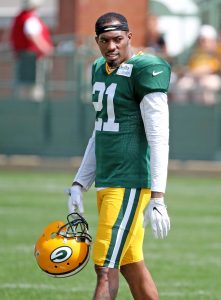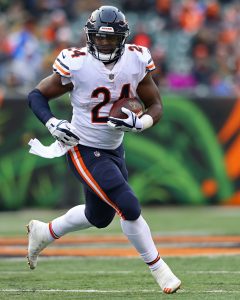Beth Bowlen “Not Qualified” To Be Broncos Controlling Owner
Beth Bowlen, the second-oldest child of former Broncos owner Pat Bowlen, has informed Broncos ownership that she is interested in taking over as controlling owner of the team. However, The Pat Bowlen Trust, set up following the owner’s retirement in 2014 from Alzheimer’s disease, told the younger Bowlen that she is not qualified for the position, Nicki Jhabvala writes in an in-depth piece for The Athletic. 
“I have completed the criteria laid out by the trustees, so I felt it was a good time to come out and express my interest and desire to be a part of the organization again,” Bowlen told The Athletic.
Trust member and team president/CEO Joe Ellis released a more in-depth statement, which said that Beth Bowlen was not in the original leadership plans set out by Pat before his retirement.
“Pat did not designate Beth as a trustee or appoint her to a leadership position, nor did he instruct the trustees to specifically mentor her. He made it clear that his children were not automatically entitled to a role with the team and that they would have to earn that opportunity through their accomplishments, qualifications and character.
“As trustees honoring the clear wishes of Pat, we have thoroughly evaluated whether Beth is capable of succeeding her father as controlling owner. We have determined that she is not capable or qualified at this time.”
Among the qualifications set aside for the successor, Jhabvala mentions “A bachelor’s degree paired with an MBA, J.D. or other advanced business-related degree was one. So was at least five years of “senior management experience” with the NFL, the Broncos or the Stadium Manage Company (SMC), the organization that runs the team’s stadium in Denver.”
Ellis also mentioned that Beth Bowlen has declined to meet with the trust for the last two years to discuss her qualifications. She has reportedly given the trust her succession plan which would include a mentorship program with the team’s front office before growing to include each of the other six Bowlen children.
The trust was formed more than a decade before the owner’s diagnosis and includes, along with Ellis, team counsel Rich Slivka and Denver attorney Mary Kelly. Ellis represents the team at league functions.
The plan is still for a member of the Bowlen Family, which has owned the Broncos since 1984, to take over the reins. Brittany Bowlen, 28, considered by many the frontrunner for the job, has yet to comment on the new situation, as 9 News’ Mike Klis tweets. Jhabvala notes a quote from Ellis in 2016, “When a child emerges that has the capability and has earned the right to have that job and take over their father’s chair, the three trustees will determine that.
Minor NFL Transactions: 5/31/2018
Here are today’s minor moves:
Arizona Cardinals
- Retired: FB Austin Ramesh
Carolina Panthers
- Waived: OT Zach Banner
Kansas City Chiefs
- Signed: Jordan Smallwood
- Waived/Injured: Davon Grayson
NFC Notes: Bears, OBJ, Rodgers, Kaepernick
Bears wide receiver and 2015 first-round pick Kevin White “can’t be a lock to make the 53-man roster coming out of preseason,” according to the Chicago Tribune’s Bradd Biggs.
Briggs continues by saying, “White is guaranteed a little more than $2.69MM this season. While there is offset language in his contract, there’s no way another team would pay him that kind of money, so the Bears would be on the hook for at least a portion if they were to release him. It’s not enough money to say he’s locked into a spot.”
The sentiment is not a shocker. After the Bears overhauled their receiving corps with Allen Robinson, Taylor Gabriel and rookie pass catcher Anthony Miller, the injury-prone wideout will have to make an impact on the field to assure his roster spot.
The second receiver taken in 2015, behind Amari Cooper, White boasted an impressive combination of size, speed and strength that projected the West Virginia product to be Chicago’s future No. 1 receiver. Instead, he has been ravaged by injuries that have limited him to just five games in three seasons. He flashed signs of progress in 2016 with back-to-back six-catch games, but he immediately suffered a high ankle sprain that resulted in a fracture and sidelined him for the remainder of the season.
Briggs notes that he has made progress and all signs are pointing positive early at OTAs. “The coaches are saying the right things about him. They like the way he looks. They like his work ethic and approach.”
If White is able to produce at even a fraction of his potential in 2017, Mitch Trubisky will have plenty of weapons to operate with in his sophomore campaign.
Here’s more from around the NFC:
- The Giants and wide receiver Odell Beckham Jr. could be nearing a contract showdown, writes Ralph Vacchiano of SportsNet New York. Once the Pro Bowl pass catcher is cleared to fully practice he could opt for a holdout since he has yet to publicly dismiss an earlier report that he “will not set foot on a field without a contract extension.” Though that option is not a certainty, Vacchiano notes Beckham’s leverage is rather strong, in that the Giants are in win-now mode with an aging quarterback who has struggled without his go-to receiver. Holdouts rarely go the way of the player, but we’ll see if Beckham tries to buck the trend.
- When the Packers sit down at the negotiating table with Aaron Rodgers on an extension, one thing the quarterback will be looking for is a possible out on his deal, reports NFL Network’s Mike Garafolo (Twitter link). “Another aspect that I’m told is extremely important to [Rodgers] is player control — How much control can he have on his future,” Garafolo said. The All-Pro quarterback will almost assuredly become the highest-paid player in the league when he signs a deal, which seems like a slam dunk at this point, but his ability to have an out in the deal is one thing to keep an eye on.
- The attorney for former 49ers quarterback Colin Kaepernick and safety Eric Reid, Mark Geragos, told reporters, “I would stay tuned because this case is about to take a dramatic turn.” Asked about the claim, Geragos added, “somebody has decided they were to dime out the NFL for what they were doing.” This implies there being a witness who can contradict the NFL’s stance that each team decided neither player can help their roster. There is sure to be more to develop in this case in the coming days.
Clinton-Dix Skips Packers OTAs
Packers safety Ha Ha Clinton-Dix is skipping organized team activities, Pro Football Talk’s Charean Williams writes. 
The 2016 Pro Bowl selection has yet to comment on his absence, but Williams speculates he could be looking for an extension as he plays 2018 under his fifth-year option worth $5.96MM.
Clinton-Dix has yet to miss a game in his four-year career, and has started every game in each of the last three seasons. He enjoyed his best season in 2016, when he earned Second Team All-Pro honors after snagging a team-best five interceptions. Though he logged three picks in 2017, the Packers also allowed the fourth-most passing touchdowns and ranked in the bottom ten in passing yards allowed.
Green Bay isn’t letting the absence slow down their program. “It’s voluntary. So the guys that are here are the guys that we’re worried about,” defensive passing game coordinator Joe Whitt told Ryan Wood of the Green Bay Press-Gazette.
Cardinals Sign Mason Cole
The Cardinals have wrapped up their 2018 draft class. On Thursday, Arizona inked their final straggler in third round centerMason Cole. 
Cole, a Michigan product, owns the distinction of being the first true freshman offensive lineman in program history to start the season opener. He did so at the left tackle position, where he spent the first two years of his collegiate career. Starting with his junior season, Cole made the switch to the middle when Graham Glasgow left for the NFL. In the pros, Cole projects to serve as Arizona’s backup center behind starter A.Q. Shipley.
Here’s the complete rundown of the Cardinals’ draft class:
- 1-10: Josh Rosen, QB (UCLA): Signed
- 2-47: Christian Kirk, WR (Texas A&M): Signed
- 3-97: Mason Cole, C (Michigan): Signed
- 4-134: Chase Edmonds, RB (Fordham): Signed
- 6-182: Christian Campbell, CB (Penn State): Signed
- 7-254: Korey Cunningham, T (Cincinnati): Signed
As of this writing, 12 third round draft picks in the 2018 class remain unsigned. In total, 54 of this year’s 256 picks have yet to ink their deals.
BIlls Release C Eric Wood
The Bills have officially released center Eric Wood. Wood, who retired earlier this offseason due to a neck injury, has agreed to an injury settlement with the team. 
Wood, 32, was Buffalo’s starting snapper from 2009 through 2017. Prior to his retirement, he was Buffalo’s second-longest-tenured active player behind defensive tackle Kyle Williams. Over the course of his Bills tenure, he was team’s top center under six different head coaches, or seven if you count Anthony Lynn‘s one game as interim head coach.
Remarkably, he started in all 16 of the Bills’ regular season games last season, plus their playoff game against Jacksonville. Wood managed to play through the pain all year, but the malady was too serious for him to continue on the field.
Wood graded out as the No. 16 center in the NFL in 2017, per Pro Football Focus’ advanced metrics. In 2015, the season in which he his first and only Pro Bowl, PFF had him ranked in the top five league-wide.
With Wood out of the picture, the Bills project to start free agent pickup Russell Bodine in the middle. Interior lineman Ryan Groy figures to serve as his top backup.
Bears’ Jordan Howard To Be “Main Guy”
Earlier this year, Bears running back Jordan Howard was the subject of trade speculation. Based on what Howard has been hearing, there should be no more questions about his place on the team. 
[RELATED: Former Bears LB Shea McClellin Leaning Towards Retirement]
“[New head coach Matt Nagy] already said I’m going to be the main guy,” Howard said (via Adam L. Jahns of the Sun Times).
Nagy has also indicated that Howard is in for a big workload, though he cautioned that his offense doesn’t require a bell-cow back in every game. With Howard penciled in for a significant number of carries, it seems unlikely that he’ll be shipped out, which jibes with what the team told him in April.
Howard, a fifth-round pick in the 2016 draft, has easily topped 1,000 rushing yards in each of his two NFL seasons. Given that Howard as a firm grip on the top RB spot over backups Tarik Cohen, Benny Cunningham, and Taquan Mizzell, he could have another highly productive year on the horizon.
Howard is one of the better running backs in the league and also one of the very best values at the position. He is under contract for another two years with modest cap hits of $692K in 2018 and $782K in 2019.
AFC Notes: Kendricks, Raiders, Colts, Simon
Mychal Kendricks‘ left his visit with the Raiders on Wednesday without signing a deal, as Vic Tafur of The Athletic tweets. With that in mind, Kendricks’ scheduled visit with the Browns should take place this week.
Kendricks has been vocal about his desire to play with his brother in Minnesota, but the Vikings’ level of interest is not immediately clear following their meeting. Minnesota arguably would give Kendricks the easiest path towards another Super Bowl ring, but the Browns – armed with upwards of $70MM in cap room – could be the highest bidder of the bunch. The Raiders, meanwhile, would have to do some maneuvering to sign Kendricks given that they have just $1.7MM in cap room.
Here’s more from the AFC:
- The Colts could conceivably cut John Simon this summer, Stephen Holder of the Indy Star writes. Simon performed well in an injury-shortened 2017, but new defensive coordinator Matt Eberflus is looking to play him at defensive end rather than middle or strong-side linebacker. Simon, listed at (a perhaps inflated) 6’2″and 260 pounds, is undersized for DE and may not have the speed needed to get around pass blockers. Given that Simon is now battling with edge rushers like Jabaal Sheard, Tarell Basham, Kemoko Turay, Chris McCain, Tyquan Lewis, it’s possible that he might not make the final cut. Simon, who signed a three-year, $14MM deal with the Colts just last year, has no guaranteed money remaining on his deal. The Colts would save $3.28MM against the cap by releasing Simon.
- Darryl Slater of NJ.com estimates that any suspension for Jets wide receiver Robby Anderson would be of the shorter variety. Recently, Florida prosecutors dropped felony charges against Anderson, though he still faces six charges stemming from a January incident in which he was arrested and threatened to sexually assault the wife of a police officer.
Details On Brandon Marshall’s Contract
The Seahawks don’t have much to lose in their contract with wide receiver Brandon Marshall. The veteran’s $90K signing bonus represents the only guaranteed portion of his one-year deal, according to ESPN.com’s Field Yates (on Twitter). 
The modest signing bonus means that the Seahawks can bail on the deal between now and September if Marshall does not play up to par in practice. If he does make the team, he’s in line for just $1.015MM in base pay. After that, he can earn another $1MM through incentives to bring the value of his deal as high as $2.155MM. Here’s the complete breakdown of those bonuses, courtesy of Yates:
- 40-49 receptions: $75K
- 50-59 receptions: $125K
- 60-69 receptions: $250K
- 70+ receptions: $350K
- 500-599 receiving yards: $75K
- 600-699 yards: $125K
- 700-799 receiving yards: $250K
- 800+receiving yards: $350K
- 7+ receiving touchdowns: $350K
Assuming all goes well in Seattle over the next three months and change, a decent chunk of Marshall’s incentives should be attainable. Even in a down year with the Jets in 2016, Marshall still had 59 catches for 788 yards and three touchdowns. If he were to reprise that stat line, the 34-year-old would earn $375K of the potential ~$1MM payout. Add another reception to that total and Marshall is looking at $500K, roughly half of his potential bonus earnings.
Of course, Marshall didn’t come close to those numbers last year as an early season injury sidelined him for all but five games in 2017. He’ll do his best to get back to his 2015 output when he had 109 catches for 1,502 yards and 14 touchdowns – numbers that would allow him to max out his Seahawks deal and, more importantly, position him for a better deal in 2019, should he choose to continue playing in his age-35 season. In December, Marshall indicated that he would like to play through the ’19 season.
If Marshall is healthy, it wouldn’t be surprising to see him positioned as the team’s No. 2 wide receiver behind Doug Baldwin. Tyler Lockett, free agent addition Jaron Brown, and speedy trade acquisition Marcus Johnson figure to round out Seattle’s top five. Until last year’s injury-shortened season, Marshall averaged 164 targets per 16 games as an NFL starter.
Explaining Post-June 1 Cuts
NFL teams will often use bonuses in contracts as a way to spread out a cap hit that might otherwise be exorbitant. For instance, if a player’s five-year deal includes a $10MM signing bonus, that money can be paid immediately but spread out over five years for cap purposes. This way, the cap charge for the bonus amounts to $2MM per year for cap purposes, rather than $10MM in year one.
However, this practice can come back to haunt teams if they want to get out of a contract early. Suppose the team in the above scenario wanted to release the player in the third year of his contract. Even if none of the player’s base salary is guaranteed at that point, the team will still have to account for that remaining prorated bonus money. Rather than counting on the cap as $2MM per year for three seasons, that dead money “accelerates,” and applies to the cap for the league year in which the player is released. In other words, the remaining $6MM in prorated bonus money immediately counts against the club’s cap.
Although these rules apply to many cuts, a different set of rules is in place for players released after June 1. In that case, a team can spread the cap hit across two seasons rather than one — for the current season, the prorated bonus figure stays at its original amount, with the remaining bonus balance accelerating onto the following season. Referring again to the above scenario, that means the player would count against the cap for $2MM in the league year in which he was cut, with the remaining $4MM applying to the following league year.
The guidelines for pre-June 1 and post-June 1 cuts are fairly straightforward, but things become a little more complicated when we take into account that teams are allowed to designate up to two players as post-June 1 cuts even if those players are released before June. This offseason, we’ve seen a number of players designated as post-June 1 cuts, including Ndamukong Suh (Dolphins), Orlando Scandrick (Cowboys), Mychal Kendricks (Eagles), and Coby Fleener (Saints).
In the case of Kendricks, the Eagles were initially slated to pay him a $5.85MM in base salary this year with a $7.6MM cap figure. Under typical circumstances, the release would have left the Eagles with a $3.2MM dead money obligation for 2018. However, through the post-June 1 designation, they will unlock $6MM in cap space starting on Friday with just $1.6MM in dead money this year. In 2019, they’ll be faced with the remaining $1.6MM charge.
Because the cap charge for the current league year isn’t reduced until June, designating a player as a post-June 1 cut isn’t hugely advantageous for teams. By June, just about every notable free agent is off the board, so the new savings likely won’t be put toward a major move.
Still, releasing a player in March and designating him a post-June 1 cut can be mutually beneficial for a player and his team. It allows the player to hit the market when potential suitors still have cap room and are still looking to add free agents, and it allows the club to spread out the player’s cap charge without having to actually wait until June 1 to release him — waiting until that point could mean paying roster or workout bonuses in the interim. Additionally, even if the team doesn’t need that June cap space for free agency, it can come in handy for signing draft picks.
In the case of the defending champs, who faced a serious numbers crunch heading into the offseason, the June 1 designation allowed for some much-needed wiggle room. Before the move, the Eagles had an NFL-low $103K available under the cap.
A couple loose ends related to post-June 1 cuts:
- The same rules applying to players who are released apply to players who are traded — if a team trades a player after June 1, his remaining bonus money can be spread out over two seasons. However, a club can’t designate anyone traded prior to June as a post-June 1 player.
- Teams cannot designate post-June 1 cuts during the final league year of the Collective Bargaining Agreement.
Note: This is a PFR Glossary entry. Our glossary posts explain specific rules relating to free agency, trades, or other aspects of the NFL’s Collective Bargaining Agreement. Information from Over the Cap was used in the creation of this post. The original version of this post was published on April 2, 2014.
